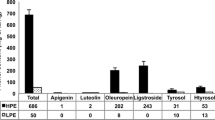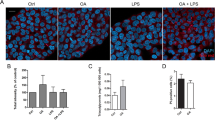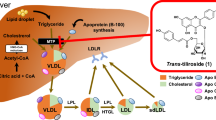Abstract
The essential oils (EOs) of Lippia alba, an herb extensively used as a folk medicine in Latin America, are today promoted as an effective means of eliminating problems caused by hyperlipemia. We hypothesized that L.alba EOs inhibited cholesterol and triacylglycerols synthesis and decreased the intracellular depots of those lipids (lipid droplets), mechanisms involving the induction of a hypolipidemic response. Our aim was, therefore, to evaluate the hypolipogenic capability of the EOs of four L. alba chemotypes on liver-derived (HepG2) and non-liver (A549) human cell lines and to identify the potential biochemical targets of those chemotypes, particularly within the mevalonate pathway (MP). [14C]Acetate was used as radioactive precursor for assays. Lipid analyses were performed by thin-layer and capillary gas chromatography, lipid droplets analyzed by fluorescence microscopy, and HMGCR levels determined by Western blot. In both cell lines, all four chemotypes exerted hypocholesterogenic effects within a concentration range of 3.2–32 µg/mL. Nonsaponifiable lipids manifested a decrease in incorporation of [14C]acetate into squalene, lanosterol, lathosterol, and cholesterol, but not into ubiquinone, thus suggesting an inhibition of enzymes in the MP downstream from farnesyl pyrophosphate. The tagetenone chemotype, the most efficacious hypocholesterogenic L. alba EO, lowered HMGCR protein levels; inhibited triacylglycerols, cholesteryl esters, and phospholipids synthesis; and diminished lipid droplets in size and volume. These results revealed that L. alba EOs inhibited different lipogenic pathways and such lipid-lowering effects could prove essential to prevent cardiovascular diseases.











Similar content being viewed by others
Abbreviations
- C:
-
Cholesterol
- CE:
-
Cholesteryl esters
- ChoGpl:
-
Choline glycerophospholipids
- EOs:
-
Essential oils
- EtnGpl:
-
Ethanolamine glycerophospholipids
- HMGCR:
-
3-Hydroxy-3-methylglutaryl-coenzyme A reductase
- LaEO:
-
Lippia alba essential oil
- LaEOca:
-
Lippia alba essential oil carvone chemotype
- LaEOci:
-
Lippia alba essential oil citral chemotype
- LaEOpi:
-
Lippia alba essential oil piperitone chemotype
- LaEOta:
-
Lippia alba essential oil tagetenone chemotype
- LD:
-
Lipid droplet
- PL:
-
Phospholipids
- PtdSer:
-
Phosphatidylserines
- TAG:
-
Triacylglycerols
References
Blanco MA, Colareda GA, van Baren C, Bandoni AL, Ringuelet J, Consolini AE (2013) Antispasmodic effects and composition of the essential oils from two South American chemotypes of Lippia alba. J Ethnopharmacol 149:803–809
Badilla B, Cambronero J, Cicció J, Cordero T, Mora G (2007) Determination of topical anti-inflammatory activity of the essential oil and extracts of Lippia alba (Mill.) NE Brown (Verbenaceae), using the model of mouse ear edema induced by TPA and AA. Pharmacogn Mag 3:139
Viana GS, do Vale TG, Rao V, Matos F (1998) Analgesic and antiinflammatory effects of two chemotypes of Lippia alba: a comparative study. Pharm Biol 36:347–351
Viana GSdB, Vale TGd, Silva CMM, Matos FJdA (2000) Anticonvulsant activity of essential oils and active principles from chemotypes of Lippia alba (Mill.) NE Brown. Biol Pharm Bull 23:1314–1317
Chies CE, Branco CS, Scola G, Agostini F, Gower AE, Salvador M (2013) Antioxidant Effect of Lippia alba (Miller) NE Brown. Antioxidants 2:194–205
Pascual E, Slowing K, Carretero E, Villar Á (2001) Antiulcerogenic activity of Lippia alba (Mill.) NE Brown (Verbenaceae). Il Farmaco 56:501–504
Guerrero M, Puebla P, Carrón R, Martın M, Arteaga L, San Román L (2002) Assessment of the antihypertensive and vasodilator effects of ethanolic extracts of some Colombian medicinal plants. J Ethnopharmacol 80:37–42
Darwick S (2013) Juanilama: leaves that combat cholesterol [Internet]. in Juanilama: leaves that combat cholesterol
Hennebelle T, Sahpaz S, Joseph H, Bailleul F (2008) Ethnopharmacology of Lippia alba. J Ethnopharmacol 116:211–222
Ricciardi G, Ciccio JF, Ocampo R, Lorenzo D, Ricciardi A, Bandoni A, Dellacassa E (2009) Chemical variability of essential oils of Lippia alba (Miller) NE Brown growing in Costa Rica and Argentina. Nat Prod Commun 4:853–858
Fischer U, Lopez R, Pöll E, Vetter S, Novak J, Franz CM (2004) Two chemotypes within Lippia alba populations in Guatemala. Flavour Fragr J 19:333–335
Cicció J, Ocampo R (2010) Distribución biogeográfica de Lippia alba (Mill.) NE Br. ex Britton & Wilson y quimiotipos en América y el Caribe. Normalización de Productos Naturales Obtenidos de Especies de la Flora Aromática Latinoamericana EdiPUCRS, Porto Alegre p 107–130
Ricciardi G, Ricciardi A, and Bandoni A (2000) Fitoquímica de verbenáceas (Lippias y Aloysias) del Nordeste argentino. Comunicaciones Científicas y Tecnológicas
Buhaescu I, Izzedine H (2007) Mevalonate pathway: a review of clinical and therapeutical implications. Clin Biochem 40:575–584
Chaverri C, Cicció JF (2015) Leaf and fruit essential oil compositions of Pimenta guatemalensis (Myrtaceae) from Costa Rica. Revista de Biología Tropical 63:303–311
Folch J, Lees M, Sloane-Stanley G (1957) A simple method for the isolation and purification of total lipids from animal tissues. J Biol Chem 226:497–509
Chen P Jr, Tt Toribara, Warner H (1956) Microdetermination of phosphorus. Anal Chem 28:1756–1758
Layerenza J, González P, De Bravo MG, Polo M, Sisti M, Ves-Losada A (2013) Nuclear lipid droplets: a novel nuclear domain. Biochimica et Biophysica Acta (BBA)-Mol Cell Biol Lipids 1831:327–340
Polo MP, de Alaniz MJ, de Bravo MG (2005) Algunos aspectos de la regulación de la síntesis de mevalonato en células Hep G2 en cultivo. FABICIB 6:9–17
Mamun-Or-Rashid ANMSMK, Jamal MAHM, Nasrin S (2013) A Comprehensive Ethnopharmacological Review on Lippia alba M. Int J Biomed Mater Res 1:14–20
Linde G, Colauto N, Albertó E, Gazim Z (2016) Quimiotipos, Extracción, Composición y Aplicaciones del Aceite Esencial de Lippia alba. Revista Brasileira de Plantas Medicinais 18:191–200
de Santana BF, Voeks RA, Funch LS (2016) Ethnomedicinal survey of a maroon community in Brazil’s Atlantic tropical forest. J Ethnopharmacol 181:37–49
Olivero-Verbel J, Guerrero-Castilla A, Stashenko E (2010) Toxicity of the essential oil of the cytral chemotype. Acta Toxicol Argent 18:21–27
Chung MJ, Park KW, Kim KH, Kim C-T, Baek JP, Bang K-H, Choi Y-M, Lee S-J (2008) Asian plantain (Plantago asiatica) essential oils suppress 3-hydroxy-3-methyl-glutaryl-co-enzyme A reductase expression in vitro and in vivo and show hypocholesterolaemic properties in mice. Br J Nutr 99:67–75
Galle M, Kladniew BR, Castro MA, Villegas SM, Lacunza E, Polo M, de Bravo MG, Crespo R (2015) Modulation by geraniol of gene expression involved in lipid metabolism leading to a reduction of serum-cholesterol and triglyceride levels. Phytomedicine 22:696–704
Jayachandran M, Chandrasekaran B, Namasivayam N (2015) Effect of geraniol, a plant derived monoterpene on lipids and lipid metabolizing enzymes in experimental hyperlipidemic hamsters. Mol Cell Biochem 398:39–53
Polo MP, De Bravo MG (2006) Effect of geraniol on fatty-acid and mevalonate metabolism in the human hepatoma cell line Hep G2. Biochem Cell Biol 84:102–111
Fujimoto T, Parton RG (2011) Not just fat: the structure and function of the lipid droplet. Cold Spring Harbor Perspect Biol 3:a004838
Penno A, Hackenbroich G, Thiele C (2013) Phospholipids and lipid droplets. Biochimica et Biophysica Acta (BBA)-Mol Cell Biol Lipids 1831:589–594
Lennernäs H, Fager G (1997) Pharmacodynamics and pharmacokinetics of the HMG-CoA reductase inhibitors. Clin Pharmacokinet 32:403–425
Skarlovnik A, Janić M, Lunder M, Turk M, Šabovič M (2013) Coenzyme Q10 supplementation decreases statin-related mild-to-moderate muscle symptoms: a randomized clinical study. Med Sci Monit 20:2183–2188
Acknowledgements
This work was supported by research Grants from the Consejo Nacional de Investigaciones Científicas y Técnicas Argentina, the Agencia Nacional de Promoción Científica y Tecnológica, and the Universidad Nacional de La Plata. We would like to thank José Cicció-Alberti, CIPRONA, Universidad de Costa Rica, for kindly supplied the essential oils of Lippia alba. We are also grateful to Dr. Donald F. Haggerty, a retired academic career investigator and native English speaker, for editing the final version of the manuscript.
Author information
Authors and Affiliations
Corresponding author
Ethics declarations
Conflict of interest
The authors declare no conflict of interest.
About this article
Cite this article
Montero-Villegas, S., Polo, M., Galle, M. et al. Inhibition of Mevalonate Pathway and Synthesis of the Storage Lipids in Human Liver-Derived and Non-liver Cell Lines by Lippia alba Essential Oils. Lipids 52, 37–49 (2017). https://doi.org/10.1007/s11745-016-4218-x
Received:
Accepted:
Published:
Issue Date:
DOI: https://doi.org/10.1007/s11745-016-4218-x




